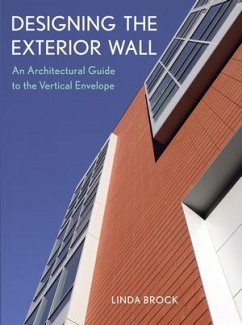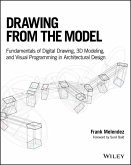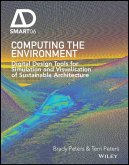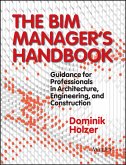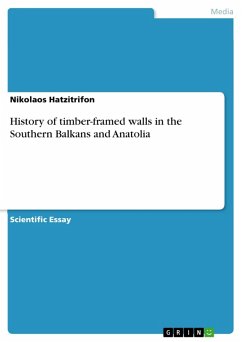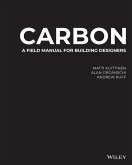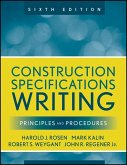

Alle Infos zum eBook verschenken

- Format: ePub
- Merkliste
- Auf die Merkliste
- Bewerten Bewerten
- Teilen
- Produkt teilen
- Produkterinnerung
- Produkterinnerung

Hier können Sie sich einloggen

Bitte loggen Sie sich zunächst in Ihr Kundenkonto ein oder registrieren Sie sich bei bücher.de, um das eBook-Abo tolino select nutzen zu können.
By presenting the basics of building science along with a prescribed set of details, Designing the Exterior Wall helps you understand why buildings fail and how they can be made more durable through design. Author Linda Brock connects the science and aesthetics of building envelopes through the examination of a variety of construction and cladding types. She features details from real world projects in a variety of climates, successful and unsuccessful case studies, and checklists you can use on your own projects. * Helps you reduce your liability by showing why building envelopes fail and how…mehr
- Geräte: eReader
- mit Kopierschutz
- eBook Hilfe
- Größe: 23.39MB
![Drawing from the Model (eBook, ePUB) Drawing from the Model (eBook, ePUB)]() Frank MelendezDrawing from the Model (eBook, ePUB)59,99 €
Frank MelendezDrawing from the Model (eBook, ePUB)59,99 €![Computing the Environment (eBook, ePUB) Computing the Environment (eBook, ePUB)]() Brady PetersComputing the Environment (eBook, ePUB)44,99 €
Brady PetersComputing the Environment (eBook, ePUB)44,99 €![The BIM Manager's Handbook (eBook, ePUB) The BIM Manager's Handbook (eBook, ePUB)]() Dominik HolzerThe BIM Manager's Handbook (eBook, ePUB)34,99 €
Dominik HolzerThe BIM Manager's Handbook (eBook, ePUB)34,99 €![History of timber-framed walls in the Southern Balkans and Anatolia (eBook, ePUB) History of timber-framed walls in the Southern Balkans and Anatolia (eBook, ePUB)]() Nikolaos HatzitrifonHistory of timber-framed walls in the Southern Balkans and Anatolia (eBook, ePUB)15,99 €
Nikolaos HatzitrifonHistory of timber-framed walls in the Southern Balkans and Anatolia (eBook, ePUB)15,99 €![Integrating Innovation in Architecture (eBook, ePUB) Integrating Innovation in Architecture (eBook, ePUB)]() Ajla AksamijaIntegrating Innovation in Architecture (eBook, ePUB)45,99 €
Ajla AksamijaIntegrating Innovation in Architecture (eBook, ePUB)45,99 €![Carbon (eBook, ePUB) Carbon (eBook, ePUB)]() Matti KuittinenCarbon (eBook, ePUB)46,99 €
Matti KuittinenCarbon (eBook, ePUB)46,99 €![Construction Specifications Writing (eBook, ePUB) Construction Specifications Writing (eBook, ePUB)]() Mark KalinConstruction Specifications Writing (eBook, ePUB)96,99 €
Mark KalinConstruction Specifications Writing (eBook, ePUB)96,99 €-
-
-
Dieser Download kann aus rechtlichen Gründen nur mit Rechnungsadresse in A, B, BG, CY, CZ, D, DK, EW, E, FIN, F, GR, HR, H, IRL, I, LT, L, LR, M, NL, PL, P, R, S, SLO, SK ausgeliefert werden.
- Produktdetails
- Verlag: John Wiley & Sons
- Seitenzahl: 400
- Erscheinungstermin: 17. November 2015
- Englisch
- ISBN-13: 9781119139706
- Artikelnr.: 44219382
- Verlag: John Wiley & Sons
- Seitenzahl: 400
- Erscheinungstermin: 17. November 2015
- Englisch
- ISBN-13: 9781119139706
- Artikelnr.: 44219382
- Herstellerkennzeichnung Die Herstellerinformationen sind derzeit nicht verfügbar.
Acknowledgments.
Using This Book.
PART 1: CHOOSING THE COMPONENTS.
Chapter 1: Decisions That Affect the Exterior Wall.
1.1 Introduction to the Building Envelope.
1.2 Decisions Affecting Aesthetics, Function, Durability, and the Budget.
1.3 Climate and the Exterior Wall.
1.4 Function of the Exterior Wall.
1.5 Cladding Systems.
1.6 "Whole-Wall" Design.
1.7 Selecting and Positioning the Barriers and Retarders.
CHECKLIST: Preliminary Design Information and Decisions.
Chapter 2: Water Barriers and Flashings.
2.1 Managing Water.
2.2 Water Management Systems.
2.3 Selecting the Right Water Management System.
2.4 Water Barriers and Their Placement.
2.5 Installation.
2.6 Flashings.
2.7 Testing and Measuring Water Leakage.
2.8 Quick Notes: Water Ingress.
Chapter 3: Air Barrier Systems, Vapor Retarders, and Insulation.
3.1 Stopping Air and Controlling Thermal and Vapor Transfer.
3.2 Air Movement: Loss of Conditioned and Vapor-Laden Air.
3.3 Vapor Transmission by Diffusion.
3.4 Heat Transfer by Conduction And Radiation.
Chapter 4: Sealant Joints.
4.1 Structural Forces and Differential Movement.
4.2 Expansion and Control Joints.
4.3 Joint Design.
4.4 Construction Tolerances.
4.5 Joint Components.
4.6 Installation of Liquid Sealants.
4.7 Maintenance.
4.8 Testing Sealants.
4.9 Quick Notes: Sealant Joints.
CHECKLIST: Selecting and Positioning Barriers and Retarders.
PART II: DETAILING FOR DURABILITY.
Chapter 5: Curtain Walls.
5.1 The Development of Curtain Walls.
5.2 Aluminum Glass Curtain Walls.
5.3 Metal- and Stone-Panel Curtain Walls.
5.4 Designing Curtain Walls with Glass, Metal, and Stone Panels.
5.5 Case Study.
5.6 Precast Concrete and Glass-Fiber Reinforced Concrete Panels.
5.7 How to Stay Out of Trouble When Designing Curtain Walls.
5.8 References.
Chapter 6: Anchored Brick Veneer.
6.1 Brick Veneer Anchored to the Steel-Stud Backup Walls of a Four- to
Twenty-Story Building.
6.2 Wall Type A: Brick Veneer Anchored To Steel-Stud Backup.
6.3 Climate.
6.4 Is ABV/SS Risky Business?
6.5 Reducing Risk.
6.6 Repelling Water.
6.7 Accommodating Differential Movement with Expansion Joints.
6.8 Designing Parapet Veneer Panels: A Special Case.
6.9 Supplemental Information On ABV/SS Components.
6.10 ABV Details.
6.11 Case Study.
6.12 Other Systems.
6.13 References.
Chapter 7 Exterior Insulation Finish System (EIFS) and Concrete Masonry
Walls.
7.1 Concrete Masonry Walls.
7.2 Single-Wythe Concrete Masonry: Face-Sealed Barrier Wall.
7.3 Exterior Insulation Finish System (EIFS).
7.4 Wall Type B: EIFS with Internal Drainage Plane on Concrete Masonry
Wall.
7.5 EIFS Design.
7.6 EIFS Installation.
7.7 Maintenance.
7.8 EIFS Concerns.
7.9 Details: EIFS.
7.10 EIFS over Light-Gauge Steel or Wood Stud Walls.
7.11 Case Study.
7.12 Case Study.
7.13 References.
Chapter 8: Wood-Frame Construction, Stucco, and Fiber-Cement Siding.
8.1 Wood-Frame Construction.
8.2 Stucco.
8.3 Wall Type C: Three-Coat Stucco on Wood Frame with Internal Drainage
Plane.
8.4 Stucco Design.
8.5 Stucco Application.
8.6 Maintenance.
8.7 Concerns with Stucco.
8.8 Details: Stucco.
8.9 Fiber-Cement Cladding.
8.10 Wall Type D: Fiber-Cement Board Siding with Drainage Cavity.
8.11 Fiber-Cement Siding Design.
8.12 Fiber-Cement Siding Installation.
8.13 Maintenance.
8.14 Concerns with Fiber-Cement Claddings.
8.15 Details: Fiber-Cement Siding.
8.16 Case Study.
8.17 References.
PART III: ADVANCING THE ENVELOPE.
Chapter 9: Terra-Cotta, EIFS, Stone, and Brick: Are They Durable?
9.1 Truth In Materials.
9.2 The Great Impostors: EIFS and Terra-Cotta.
9.3 Aesthetics and Durability: Can You Have Both with Carrara Marble?
9.4 Build It Right The First Time or Repair It Quickly: Anchored Brick
Veneer Failures.
Chapter 10: Architect's Design Kit: Form, Surface, Color, and Thick and
Thin Walls.
10.1 The Exterior Wall.
10.2 Aesthetic Kit: Form, Surface, and Color.
10.3 Westin New York at Times Square.
10.4 Experience Music Project, Seattle, Gehry Partners.
10.5 Comparisons: Mondrian Planes and Swoopy Forms.
10.6 Functional Kit: Thick and Thin Walls.
10.7 Vitra Conference Pavilion: Thicker Walls in Germany.
10.8 San Francisco Museum of Modern Art: Thin Brick That Works.
10.9 Are Two Walls Better than One?
10.10 Seattle Justice Center.
Chapter 11: Wood-Frame Construction: Designing for the Climate and the
Future.
11.1 Durability-The Linchpin of Sustainability.
11.2 Vancouver, British Columbia: "The Look That Didn't Last".
11.3 Seattle: "When It Rains, It Pours In".
11.4 What Can Be Learned from the Leaky Condos?
11.5 How To Do It Right: Two Countries, Two Climates, and Two Solutions.
11.6 Home 2000 and Winter Rains of Vancouver, British Columbia.
11.7 KST-Hokkaido House and Heavy Snow Loads of Northern Japan.
11.8 What Can Be Learned from the Two Houses?
Appendix A: Hygrothermal Maps.
Appendix B: Building Form.
Notes.
Bibliography and Resources.
Index.
Acknowledgments.
Using This Book.
PART 1: CHOOSING THE COMPONENTS.
Chapter 1: Decisions That Affect the Exterior Wall.
1.1 Introduction to the Building Envelope.
1.2 Decisions Affecting Aesthetics, Function, Durability, and the Budget.
1.3 Climate and the Exterior Wall.
1.4 Function of the Exterior Wall.
1.5 Cladding Systems.
1.6 "Whole-Wall" Design.
1.7 Selecting and Positioning the Barriers and Retarders.
CHECKLIST: Preliminary Design Information and Decisions.
Chapter 2: Water Barriers and Flashings.
2.1 Managing Water.
2.2 Water Management Systems.
2.3 Selecting the Right Water Management System.
2.4 Water Barriers and Their Placement.
2.5 Installation.
2.6 Flashings.
2.7 Testing and Measuring Water Leakage.
2.8 Quick Notes: Water Ingress.
Chapter 3: Air Barrier Systems, Vapor Retarders, and Insulation.
3.1 Stopping Air and Controlling Thermal and Vapor Transfer.
3.2 Air Movement: Loss of Conditioned and Vapor-Laden Air.
3.3 Vapor Transmission by Diffusion.
3.4 Heat Transfer by Conduction And Radiation.
Chapter 4: Sealant Joints.
4.1 Structural Forces and Differential Movement.
4.2 Expansion and Control Joints.
4.3 Joint Design.
4.4 Construction Tolerances.
4.5 Joint Components.
4.6 Installation of Liquid Sealants.
4.7 Maintenance.
4.8 Testing Sealants.
4.9 Quick Notes: Sealant Joints.
CHECKLIST: Selecting and Positioning Barriers and Retarders.
PART II: DETAILING FOR DURABILITY.
Chapter 5: Curtain Walls.
5.1 The Development of Curtain Walls.
5.2 Aluminum Glass Curtain Walls.
5.3 Metal- and Stone-Panel Curtain Walls.
5.4 Designing Curtain Walls with Glass, Metal, and Stone Panels.
5.5 Case Study.
5.6 Precast Concrete and Glass-Fiber Reinforced Concrete Panels.
5.7 How to Stay Out of Trouble When Designing Curtain Walls.
5.8 References.
Chapter 6: Anchored Brick Veneer.
6.1 Brick Veneer Anchored to the Steel-Stud Backup Walls of a Four- to
Twenty-Story Building.
6.2 Wall Type A: Brick Veneer Anchored To Steel-Stud Backup.
6.3 Climate.
6.4 Is ABV/SS Risky Business?
6.5 Reducing Risk.
6.6 Repelling Water.
6.7 Accommodating Differential Movement with Expansion Joints.
6.8 Designing Parapet Veneer Panels: A Special Case.
6.9 Supplemental Information On ABV/SS Components.
6.10 ABV Details.
6.11 Case Study.
6.12 Other Systems.
6.13 References.
Chapter 7 Exterior Insulation Finish System (EIFS) and Concrete Masonry
Walls.
7.1 Concrete Masonry Walls.
7.2 Single-Wythe Concrete Masonry: Face-Sealed Barrier Wall.
7.3 Exterior Insulation Finish System (EIFS).
7.4 Wall Type B: EIFS with Internal Drainage Plane on Concrete Masonry
Wall.
7.5 EIFS Design.
7.6 EIFS Installation.
7.7 Maintenance.
7.8 EIFS Concerns.
7.9 Details: EIFS.
7.10 EIFS over Light-Gauge Steel or Wood Stud Walls.
7.11 Case Study.
7.12 Case Study.
7.13 References.
Chapter 8: Wood-Frame Construction, Stucco, and Fiber-Cement Siding.
8.1 Wood-Frame Construction.
8.2 Stucco.
8.3 Wall Type C: Three-Coat Stucco on Wood Frame with Internal Drainage
Plane.
8.4 Stucco Design.
8.5 Stucco Application.
8.6 Maintenance.
8.7 Concerns with Stucco.
8.8 Details: Stucco.
8.9 Fiber-Cement Cladding.
8.10 Wall Type D: Fiber-Cement Board Siding with Drainage Cavity.
8.11 Fiber-Cement Siding Design.
8.12 Fiber-Cement Siding Installation.
8.13 Maintenance.
8.14 Concerns with Fiber-Cement Claddings.
8.15 Details: Fiber-Cement Siding.
8.16 Case Study.
8.17 References.
PART III: ADVANCING THE ENVELOPE.
Chapter 9: Terra-Cotta, EIFS, Stone, and Brick: Are They Durable?
9.1 Truth In Materials.
9.2 The Great Impostors: EIFS and Terra-Cotta.
9.3 Aesthetics and Durability: Can You Have Both with Carrara Marble?
9.4 Build It Right The First Time or Repair It Quickly: Anchored Brick
Veneer Failures.
Chapter 10: Architect's Design Kit: Form, Surface, Color, and Thick and
Thin Walls.
10.1 The Exterior Wall.
10.2 Aesthetic Kit: Form, Surface, and Color.
10.3 Westin New York at Times Square.
10.4 Experience Music Project, Seattle, Gehry Partners.
10.5 Comparisons: Mondrian Planes and Swoopy Forms.
10.6 Functional Kit: Thick and Thin Walls.
10.7 Vitra Conference Pavilion: Thicker Walls in Germany.
10.8 San Francisco Museum of Modern Art: Thin Brick That Works.
10.9 Are Two Walls Better than One?
10.10 Seattle Justice Center.
Chapter 11: Wood-Frame Construction: Designing for the Climate and the
Future.
11.1 Durability-The Linchpin of Sustainability.
11.2 Vancouver, British Columbia: "The Look That Didn't Last".
11.3 Seattle: "When It Rains, It Pours In".
11.4 What Can Be Learned from the Leaky Condos?
11.5 How To Do It Right: Two Countries, Two Climates, and Two Solutions.
11.6 Home 2000 and Winter Rains of Vancouver, British Columbia.
11.7 KST-Hokkaido House and Heavy Snow Loads of Northern Japan.
11.8 What Can Be Learned from the Two Houses?
Appendix A: Hygrothermal Maps.
Appendix B: Building Form.
Notes.
Bibliography and Resources.
Index.
